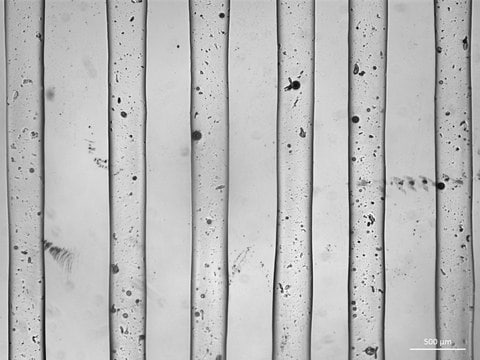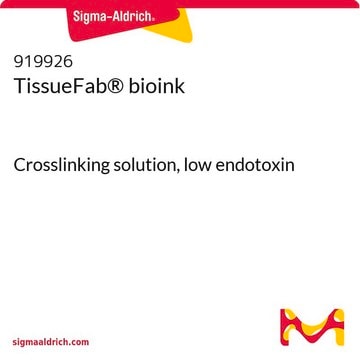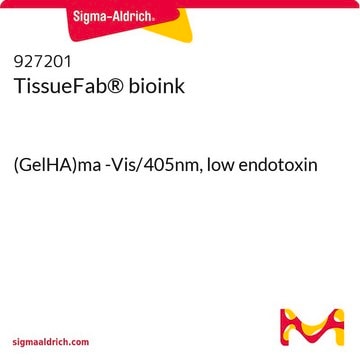934178
TissueFab® bioink
(GelHAHep)MA Vis/405 nm, low endotoxin
Synonyme(s) :
3D Bioprinting, Bioink, Controlled Release, GelMA, Gelatin, Gelatin Methacryloyl, HAMA, Heparin, Heparin Methacrylate, Hyaluronan, Hyaluronic Acid, Hyaluronic Acid Methacrylate, Hydrogel
About This Item
Produits recommandés
Niveau de qualité
Stérilité
0.2 μm filtered
Forme
gel form
Contient
<50 EU/mL Endotoxin
Composition
Gelatin, Hyaluronic acid, Heparin, Alginate
Impuretés
<5 CFU/g Bioburden ( fungal)
<5 CFU/g Bioburden (Total Aerobic)
Couleur
pale yellow to colorless
pH
6.5-7.5
Compatibilité
3D bioprinting, extrusion bioprinting
Température de stockage
2-8°C
Vous recherchez des produits similaires ? Visite Guide de comparaison des produits
Description générale
Application
- drug discovery
- in-vitro disease models
- regenerative medicine-cell-cultured meat
Caractéristiques et avantages
- Bioprinting models replicate biology for drug discovery and in vivo applications
- Sterile, low endotoxin-Batch control offers reproducible models for preclinical toxicology testing and drug screening
- Extended shelf-life & stability
Autres remarques
The methacrylate-functionalization of heparin allows thermal or photochemical crosslinking via covalent conjugation. Heparins exhibit high anionic charge densities to promote large swelling ratios in water. Heparin-based bioinks are used in tissue engineering, 3D bio-printing, and drug delivery applications.
Gelatin methacryloyl (GelMA) is a polymerizable hydrogel material derived from natural extracellular matrix (ECM) components. Due to its low cost, abundance, and retention of natural cell binding motifs, gelatin has become a highly sought material for tissue engineering applications. The addition of photocrosslinkable methacrylamide functional groups in GelMA allows the synthesis of biocompatible, biodegradable, and non-immunogenic hydrogels that are stable in biologically relevant conditions and promote cell adhesion, spreading, and proliferation.
Hyaluronic acid (HA) is a linear polysaccharide of alternating D-glucuronic acid/N-acetyl-D-glucosamine found primarily in connective tissues. HA-based hydrogels are prevalent in tissue engineering, 3D bioprinting, and drug delivery applications. The methacrylate (MA) functionalized hyaluronic acid is photo-cross-linkable.
Low Endotoxin, low bioburden: Endotoxins can negatively impact cellular growth, morphology, differentiation, inflammation, and protein expression. The bioburden is the number of contaminated organisms found in a given amount of material.
We test each lot for endotoxins in addition to total bioburden (aerobic and fungal) to minimize unwanted interactions. For more information: Cell Culture FAQs: Bacterial Endotoxin Contamination
Informations légales
Code de la classe de stockage
12 - Non Combustible Liquids
Classe de danger pour l'eau (WGK)
WGK 3
Point d'éclair (°F)
Not applicable
Point d'éclair (°C)
Not applicable
Certificats d'analyse (COA)
Recherchez un Certificats d'analyse (COA) en saisissant le numéro de lot du produit. Les numéros de lot figurent sur l'étiquette du produit après les mots "Lot" ou "Batch".
Déjà en possession de ce produit ?
Retrouvez la documentation relative aux produits que vous avez récemment achetés dans la Bibliothèque de documents.
Notre équipe de scientifiques dispose d'une expérience dans tous les secteurs de la recherche, notamment en sciences de la vie, science des matériaux, synthèse chimique, chromatographie, analyse et dans de nombreux autres domaines..
Contacter notre Service technique








